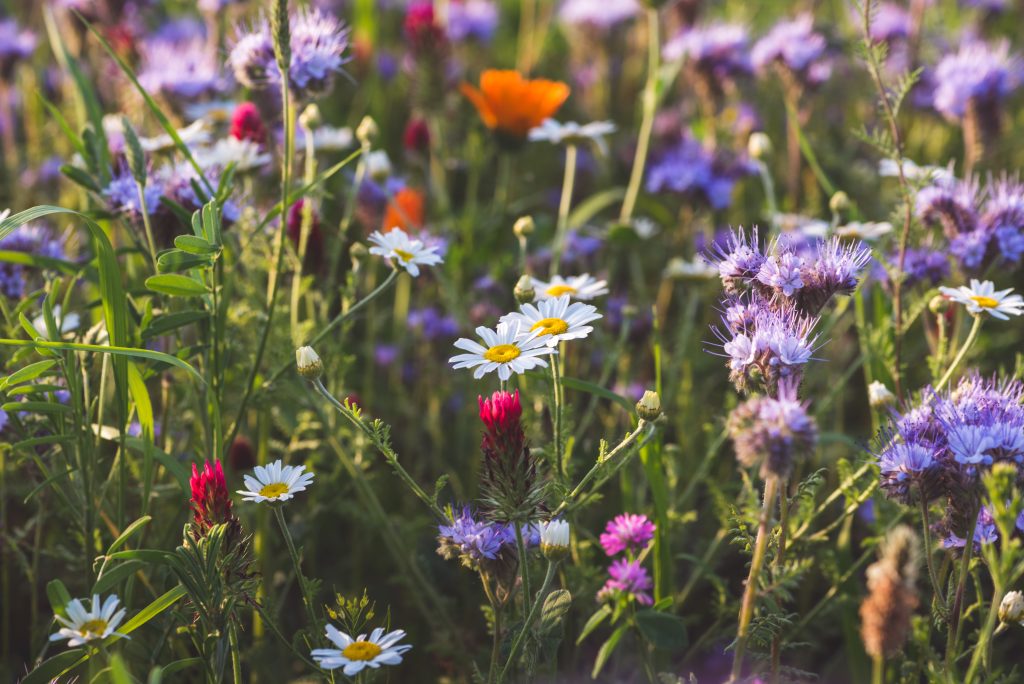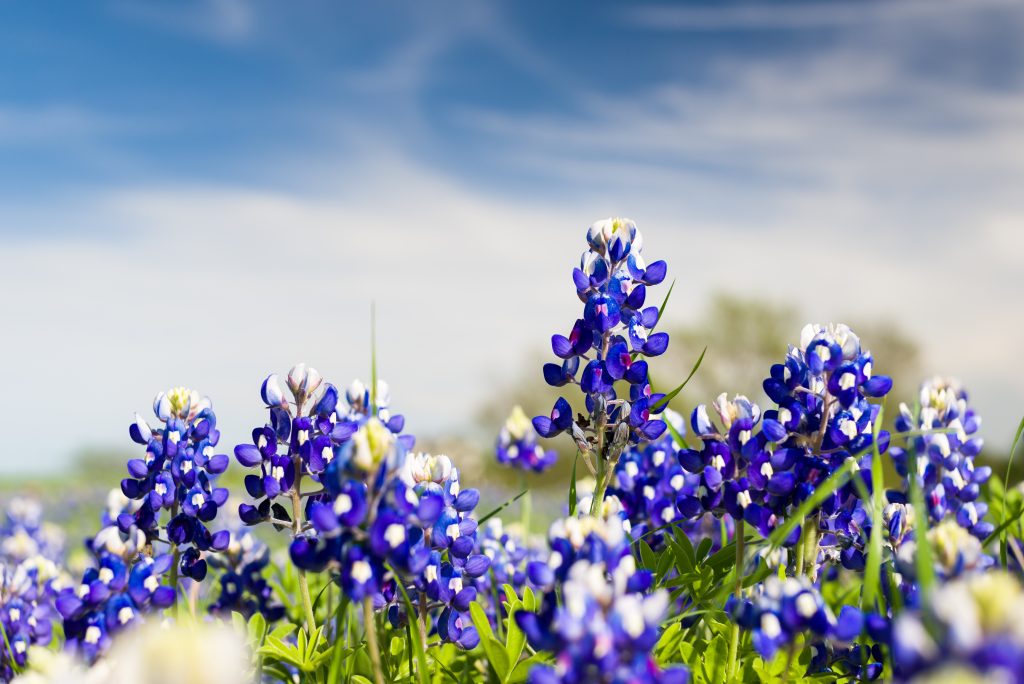RVers love nature and when nature is in its most beautiful attire, it’s covered with wildflowers. But it’s the nature of wildflowers to grow up fast and fade away, maybe lasting a month or two at most. If you want to see them year-round, you’re going to have to rely on planning and timing things just right. Don’t worry, it can be done!
What is a Wildflower
The proper definition of a wildflower is a flower that was not planted, that grows naturally in the wild. But I’m not going to be a stickler here. In some locations — think Texas and its famous Bluebonnets — wildflower seeds have been collected and intentionally planted in gardens and along highways and wayfares. Wildflowers, because they grow in the wild with basically no tending, they are hearty flowers and when you catch them in bloom, it’s like an explosion of color. No matter what variety you see.
Peak Time for Wildflowers

Image: Shutterstock
Obviously, in most places, the peak time for flowers is in spring. But spring comes at different times in different parts of the country. Here’s where that timing thing comes in.
In Florida and the southern states, wildflowers start popping out in early spring – think late February or March – and last until late fall, around Thanksgiving. In the north, they may not start showing up until late May or even early June, and last, in different waves for different species, until the first frosts of fall. Generally, they start to fade and wilt a bit in the full heat and humidity of summer.
But contrary to what many think, wildflowers bloom pretty much all year round as long as it’s not too cold. So if you want to see wildflowers year-round, you’ll want to set up a route. Fortunately, that route pretty much follows what just happens to be the favorite travel migration of many full-time RVers.
Try to Stay in 70 Degree Weather as Much as Possible

Image: Shutterstock
For most people, temperatures around 70-75 degrees are the most comfortable. The same is true for many of the most colorful wildflowers. If you start in the south in early spring and slowly make your way north to the I-10 corridor in Northern Florida and then head west, you can count on finding wildflowers all along the way.
When the weather starts hitting the 80’s and above, somewhere in Texas come late March or early April, make your way into New Mexico and use altitude to make a slight turn to the northwest, keeping those temps in the 70’s as you slowly make your way into the mountains of northern New Mexico, and on into most any place north and west you want to go in Colorado, Utah, Wyoming, and Montana.
Explore the west from May to September, Visit the National Parks, get out of the most stifling heat and keep climbing through the Rockies and beyond. Wildflowers will line your path. When the weather starts to get cold, start coming down from the mountains and pick a northern route back east like I-94 Stop and explore the Dakotas – North and South.
Meander through Minnesota on into Wisconsin following, say, US-2, into Michigan’s Upper Peninsula until the growing chills turn the Sumac brown. Come down through the Michigan Lower Peninsula and head east through Ontario, paralleling Lakes Erie and Ontario. Get to New York and the Adirondacks as fall colors peak and the northern wildflowers shrivel in the first frosts.
Then skedaddle back south watching the Geese migrate above and the fall wildflowers below until you get to someplace in Florida where the 70’s are a pretty much daily average all winter long (generally, south of a line from Sarasota on the Gulf to Port St Lucie) along the Atlantic Coast. Wildflowers will revive when the summer temps begin to drop. In the coldest months, head to the Everglades and the keys. Wildflowers bloom there pretty much all year.
The Best Wildflower Displays

Image: Shutterstock
Here are some specific wildflower blooms to look for.
- Key West – In November and December, look for Citron Zephyr Lily, Bitter Melon, and Pencilflower
- Lesser Known Florida Keys for RV Camping
- The Everglades – The glades are famous for bromeliads and epiphytic orchids. In fact, 39 native orchid species occur in the park, in addition to about 750 other kinds of native plants. Seven different orchid species bloom in January and February.
- Camping World’s Guide to RVing Everglades National Park
- Lousiana – You want to be in Lousiana in early Match into April to see the wild azaleas. A must for RVing wildflower lovers is the 31 miles long Wild Azalea Trail that begins at the Valentine Lake Recreation Area near Garner, LA, and ends at the Woodworth, LA. This is a National Recreation Trail because of its incredible beauty. There is nothing like being surrounded by wild azaleas when they’re in bloom.
- Happy Camper Bucket List – New Orleans, Louisiana
- Texas – Texas is famous for Bluebonnets. By the second week of April, you want to be in the town of Burnett, about 60 miles northwest of Austin and directly west of Georgetown on Highway 29. That’s when blooming wildflowers are usually at their peak and that’s when Burnett holds its annual Bluebonnet Festival. This year it is the weekend of April 8-10.
- 5 Texas Destinations to Visit During the Winter Months
- New Mexico – New Mexico has eight distinct ecosystems from the flat desert in the south to 12,000 foot high mountains in the north. And every spring, the state’s meadows, mountains, canyons, and deserts burst with native wildflowers. It starts in March in the southern deserts and moves northward with warming temperatures and spring rains, reaching a peak in central New Mexico by May.
- 3 New Mexico State Parks You Shouldn’t Overlook
- Wyoming/Montana/Idaho – From June through August, up and down the Rockies, wildflowers abound. In the forests, look for lupine. In the meadows and sagebrush-steppe, you’ll see spring beauties such as Indian paintbrush, glacier lilies, and steer’s head. Grand Teton, Yellowstone, and Glacier National Parks are in bloom all June and July. All throughout the west and northwest, wildflowers can be found bursting with color right in through September.
- The Most Instagramable RV Spots in Montana and Wyoming
- The Dakotas – Look for wild Asters, Vervain, and maybe mint still blooming here into September.
- The Upper Midwest and Adirondacks- Wildflowers throughout this area in September include Alstromeria, wild Chrysanthemum, and Sweet Violet. In the Adirondacks look for Bogbean, Jack in the Pulpit, and Wild Sarsaparilla.
- A Heartland Expedition: Discovering the Midwest in an RV
Get a Wildflower Identification App

Image: Shutterstock
We use an app to help us identify the wildflowers we encounter; there are a bunch to choose from. The one Jennifer and I use is called Picture This. Simply take a photo and it then identifies the flower or plant and tells you all about it. Knowing what you see makes it even more special.
As you plan your wildflower chasing RV trip, search for discounted campsites and gas along the way with the help of a Good Sam membership.
Happy Trails. And be sure to smell the flowers!
Mike Wendland is a veteran journalist who, with his wife, Jennifer, travels North America in a small motorhome, reporting about the people, places, joys, and adventure of RV life on the road at RVLifestyle.com. He and Jennifer also host the weekly RV Podcast and do twice-weekly videos on the YouTube RV Lifestyle Channel. They have written 21 books on RV travel.
By: Mike Wendland
Title: Where To See Wildflowers Year-Round
Sourced From: blog.campingworld.com/the-rv-life/where-to-go/where-to-see-wildflowers-year-round/
Published Date: Thu, 07 Apr 2022 13:00:40 +0000
---------------------------------------------
 CampingSurvivalistHuntingFishingExploringHikingPrivacy PolicyTerms And Conditions
CampingSurvivalistHuntingFishingExploringHikingPrivacy PolicyTerms And Conditions
